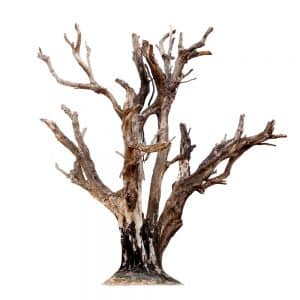Trees are expensive to plant and take years to reach maturity. So, it’s understandable to be concerned if the trees in your yard are dying. We’ll share the top reasons why this happens.
Trees in My Yard Are Dying

Poor Environmental Conditions
If the trees in your yard are all dying at once, poor environmental conditions are one of the most common culprits. For example, extended droughts can cause your trees to die from dehydration. Meanwhile, excessive rainfall can lead to root rot, particularly if your trees live in poor-draining areas.
Similarly, a change in the soil composition can cause your trees to die. Did the nearby farm start using a different spray for their plants? Did a new plant species move in that changed the soil’s acidity?
Unfortunately, controlling environmental conditions can be challenging, especially since you can’t easily transplant a tree to a more favorable area. However, if drought is the problem, we recommend periodically giving your trees a deep watering to revive them.
Insect Infestation
Insects don’t often kill trees directly, but they leave them weak and susceptible to death from poor environmental conditions.
There are three primary classifications of pests that can harm trees:
- Sap-suckers
- Wood borers
- Defoliators
Sap-suckers, such as aphids and scale insects, suck the sap out of the leaves and new tree growth. In contrast, wood borers like weevils and the Asian longhorn beetle drill directly into a tree’s trunk. Finally, defoliators like gypsy moths eat the leaves, making trees look like they’re dying.
You can apply pesticides to your trees to help manage insect infestations. But the reality is that eliminating insects altogether—especially on tall trees—is nearly impossible.
Therefore, using fertilizer to give your trees a nutritional boost and ensuring they have enough water during droughts can help them hold up against insect infestations.
If you’ve noticed a lot of webs in your trees recently, you may have an infestation of webworms or tent caterpillars.
Fungal Infection
Like insect infestations, most fungal infections won’t kill your tree directly. But fungus weakens the tree, making it difficult to withstand periods of less than ideal environmental conditions.
That said, root rot is an exception. The fungi Phytophthora and Armillaria are some of the most common strains of root rot fungus. These fungi eat away at a tree’s roots when there are extended periods of too much moisture in the soil, eventually leading to the tree’s death.
Dryer weather conditions are the best way to stop the spread of root rot. Since that’s difficult to control, should your trees die due to root rot, choose an area of your yard with better drainage the next time you plant a tree.
Too Much Competition
If you have trees that sit close together, they might be dying because there’s too much competition. The items that trees compete for to thrive include:
- Sunlight
- Water
- Nutrients in soil
- Space to grow roots
Dying trees due to too much competition is normal and part of natural selection. But this means that homeowners have control over competing conditions; by planting your trees far enough apart, you’ll be able to eliminate the possibility of competition being the cause of your tree’s death.
Should you suspect that you planted your trees too close together and they’re now dying because of it, consider helping the natural selection process by uprooting the trees that look closest to death. With any luck, the remaining trees will come back to life.
Caring for Your Trees
Trees typically require little maintenance. But that doesn’t mean they’re immune to poor environmental conditions, insects, fungus, and competition that can weaken them, leading to death.
In most cases, young or recently planted trees have the highest chance of death. Therefore, in the future, do your due diligence to know your trees’ ideal growing conditions before planting them.